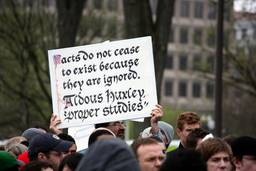GOP Unmoved by Miners’ Health Concerns While MSHA Cracks Down on Black Lung, Scofflaws
Art Levine
In an earlier political era, a major mine disaster like the explosion at Massey Energy’s Upper Big Branch Mine that killed 29 miners might have spurred Congress to take action. Not in today’s Washington: Republicans blocked passage of a new bill Wednesday that would have enabled the Mine Safety and Health Administration (MSHA) to more effectively hold repeat offender mine owners accountable and to better protect miners’ lives.
While a majority of Democrats supported the bill, to speed its consideration it required a two-thirds majority — under a “suspension of the rules” vote — that it didn’t garner, getting only a slim majority of 214 to 193 votes. Even so, the full House did approve added funding for the agency by adding administrative judges to go through the backlog of 19,000 owner appeals of enforcement actions.
After the vote on the mine safety law, House labor committee chairman Rep. George Miller (D-CA), declared, “I am deeply disappointed that Republicans turned their backs on those who work in mines every day, 600 of whom who have died in the last decade. As other mine tragedies have show us in the past, inaction today is paid for with the lives of hard-working miners tomorrow.”
And given the change to a Republican-led House in January, one Hill staffer told In These Times bluntly: “It looks unlikely that any mine safety legislation will get to Obama’s desk.”
Republicans, on the other hand, insisted that they favored a reasonable compromise, but that there was no need to be too hasty in remedying mine safety until official reports on the Massey mine disaster were completed – although the bill, in fact, seeks to reform a wide range of long-standing enforcement flaws. The incoming House Education and Labor Committee Chairman, Rep. John Kline (R-MN), released a statement:
It is always unfortunate when opportunities for bipartisan agreement fall victim to partisan politics. Democrats designed today’s vote on a mine safety bill to fail, demonstrating yet again the Majority’s contempt for the legislative process. Republicans have made clear our willingness to work in good faith to address weaknesses in the law governing mine safety and its enforcement by federal officials. However, we do not believe it is possible to effectively respond to the worst mining disaster in 40 years without a full understanding of its causes. Rather than waiting for the results of the numerous ongoing investigations, Democrats cobbled together a flawed bill and set it up for defeat.
In Washington, of course, the best way to delay action is to call for more studies or to find that the ones that have been completed are somehow insufficient.
At the same time, Massey Energy moved to close another one of its dangerous mines — in Kentucky — in the face of a pending federal legal action to close it down as still too unsafe. Despite being hobbled by loopholes in current law, all hope for protecting miners’ lives rests squarely on the traditionally lax and underfunded MHSA that is now finally springing to life. It is moving ahead with long-delayed rule-making to limit coal dust-caused “brown lung” disease and launching a new “Rules to Live By” enforcement campaign to focus on critical life-saving standards.
“They’re taking a lot more aggressive actions and moving in the right direction,” says United Mine Workers of America (UMWA) communications director Phil Smith.
On Tuesday, the mine safety agency held, in Beckley, West Virginia, the first of six hearings on a proposed rule to cut in half the amount of breathable coal dust in order to save the lives and health of miners still falling victim to brown lung disease — with 10,000 dying from it in the last decade alone. Predictably, the mining industry and other pro-business groups blasted the proposed rule as too expensive.
As Bloomberg News reported:
Federal officials should scrap or rewrite a proposed plan to protect the nation’s 73,000 coal miners from black lung disease by placing stricter limits on the amount of dust they inhale, an industry lobbyist said Tuesday.
The criticism by West Virginia Coal Association senior vice president Chris Hamilton is a first from mine operators. It also contrasts sharply with opinions from coal miners and medical professionals, who largely support the proposal.
The federal Mine Safety and Health Administration proposal would cut existing limits for breathable coal mine dust in half. It also would require miners working in the dustiest areas of mines to wear devices to continually measure dust levels and warn them if they exceed regulatory limits. Currently, dust is measured with filters that require a week or more to read in a lab.
Caused by inhaling dust, black lung has plagued coal mining for generations. Government researchers blame the chronic disease for the deaths of more than 10,000 coal miners in the past decade.
“We strongly object to the proposal in its current form,” Hamilton said at a hearing Tuesday. He said it is “fraught with technical and operational impracticalities” and suggested MSHA has dramatically underestimated how much it will cost the industry. MSHA estimates complying will cost mines $40 million a year, but Hamilton suggested it could cost more than $1 billion, though he provided no specifics.
“That’s always their complaint: the cost of taking any action to protect health in a mine costs too much,” according to UMWA General Counsel Grant Crandall. He noted in an interview with In These Times that the agency was merely seeking to put in place a 15-year old recommendation from the National Institute for Occupational Safety and Health to reduce potentially deadly dust concentration from two milligrams of dust per cubic meter to one milligram, phasing it in over a 24-month period. An agency spokesperson told In These Times via email that they weren’t sure yet when such a rule would actually be implemented, although Crandall expects it to be slowed down by legal challenges from industry.
To better protect workers, the new rule would require miners to use a personal dust monitor and regular sampling by owners of mine air quality. Yet, as Crandall points out, the steps needed to reduce the coal dust aren’t particularly high-tech: they include adding a water spraying capacity to the machines churning up dust by cutting coal seams open – and improving air flow.
Yet even some miners supportive of the new rule are a bit wary of the added dust monitor being required, an issue that will doubtless be seized on by the coal industry as it seeks to block and delay the new rule. As West Virginia Public Broadcasting reported this week:
Mike McGlothlin is 49 years old and already has black lung disease. He’s been a coal miner for 30 years. During his testimony beforeMSHA officials, he laid out his mining equipment on the table in front of them. A dusty hat with a Jesus sticker on it. A light.
He says he supports a new dust standard, but has concerns about lugging around additional equipment.
“If anyone’s been around the mines and watched coal miners that have black lung, breathing becomes a problem in their lives,” he said. “The weight of equipment or anything that you carry makes a big difference to them.”
McGlothlin said he supports the new rules, but isn’t sure how he can carry the continuous personal dust monitor the rules would require. It’s large, heavy and bulky — much like carrying a brick.
At the same hearing though, backed in general by the UMWA, the MSHA deputy assistant director put the new rule — and the required personal monitor —in context:
“The rule is trying to lower miners’ exposure to respirable coal mine dust in order to do what the coal mine act promised: end black lung,” he said.
“It’s trying to do it both through a lowering of the exposure limit, having samples taken that really reflect the true mining conditions that people are working in, and to begin the use of a personal dust monitor that will empower miners and mine operators to continually adjust the mine environment to limit coal mine dust exposure.”
The union’s safety director, Dennis O’Dell, saw some potential weaknesses in the rule that could limit its effectiveness and undermine safety. Among the most critical flaws: “History has shown us that an operator-controlled system is not credible with regard to compliance sampling. We cannot support this proposal insofar as it will have the operator being in charge. MSHA must be in charge of the sampling,” O’Dell said.
On top of that, one of the proposed approaches to dealing with an out-of-compliance mine is to move the exposed miners out rather than immediately forcing a mine to follow the new standard.
As O’Dell noted, “We do not and will not support the idea of being able to rotate miners out of their job position as the response when an operator is out of compliance. The Mine Act requires that every operator control the mine atmosphere, not move the miner in and out to lower a miners’ measured exposure.”
At the same time, the agency is taking additional steps to increase mine safety enforcement even within the limitations of current law. In November, the agency put on notice over a dozen mines that they were being targeted for repeat Pattern of Violations (POV) that could lead to stepped-up enforcement.
As a Labor Department press release noted, “These are the first mining operations to receive such notification since MSHA implemented major reforms to its POV process, including tougher provisions for mines with chronic and persistent health and safety violations.”
“I have been saying since I arrived at MSHA that the POV system is broken,” said Joseph A. Main, assistant secretary of labor for mine safety and health. “This screening represents a positive step forward, but it won’t be the only step. POV is on MSHA’s rulemaking agenda, and there are also statutory changes pending before Congress that would further improve the system.”
That approach is a change from a few decades of non-enforcement, according to the Labor Department’s own inspector general and countless newspaper investigations. And the proposed legal action to close Massey’s eastern Kentucy mine is a sign of not just new toughness but also just how weak current law is in prodding companies to make safety improvements.
Closing a mine down is a desperate last step for both the company and the federal government. Union experts see Massey’s decision as nothing more than a scofflaw company’s financial calculation. As UMWA spokesman Phil Smith says: “It demonstrates that the issues were so bad at the mine that the company determined it was cheaper to close the mine than to make it safer— although they’re taking millions out of it.” He added, “Coal operators are the most cold-hearted people under dollars-and-cents rules.”
On another front, the mine safety agency launched in October a new wave of enforcement plans under its “Rules to Live By” campaign. As a Labor Department press release explained:
The U.S. Department of Labor’s Mine Safety and Health Administration today launched the second phase of an outreach and enforcement program designed to strengthen efforts to prevent mining fatalities. “Rules to Live By II: Preventing Catastrophic Accidents” was developed from data gathered by reviewing accidents that resulted in five or more fatalities, as well as from incidents caused by fires or explosions that had the potential to result in more fatalities…
Too many miners have lost their lives in catastrophic accidents over the past 10 years,” said Joseph A. Main, assistant secretary of labor for mine safety and health. “That is simply unacceptable.
“The goal of ‘Rules to Live By II’ is to prevent major accidents — from fires to explosions — that could be disasters by having mine operators identify and correct all hazardous conditions, and direct MSHA enforcement toward confirming that violations relating to these standards and conditions are not present at mines. We are committed to scrutinizing the data on deaths in the mining industry and getting at the leading causes of those deaths to prevent subsequent ones,” said Main.
But given the backlog of 19,000 enforcement appeals by owners and loophole-laden mining laws, company owners will still be free in many ways to thumb their noses at the agency.

I hope you found this article important. Before you leave, I want to ask you to consider supporting our work with a donation. In These Times needs readers like you to help sustain our mission. We don’t depend on—or want—corporate advertising or deep-pocketed billionaires to fund our journalism. We’re supported by you, the reader, so we can focus on covering the issues that matter most to the progressive movement without fear or compromise.
Our work isn’t hidden behind a paywall because of people like you who support our journalism. We want to keep it that way. If you value the work we do and the movements we cover, please consider donating to In These Times.





